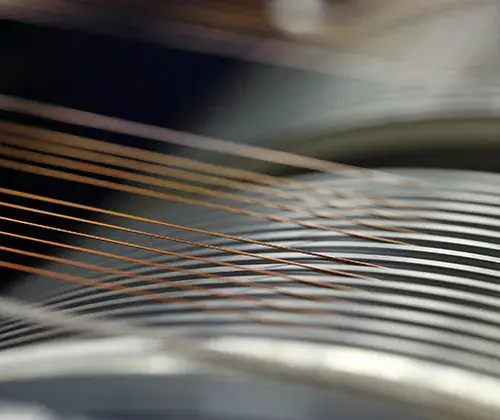
Insulated Wires for Coils of Generators in New Energy Vehicles
BACKGROUND
Technical Field
The present disclosure relates to an insulated wire obtained by coating a metal conductor with a resin, and particularly relates to an insulated wire used as a coil of an electric generator installed in, for example, electric power-driven vehicles.

Background Art
Conventionally, a round wire or a rectangular wire is employed as an insulated wire (magnet wire) used for a stator of an electric generator (motor generator) installed in automobiles. By employing a rectangular wire, a fill factor of the stator can be increased as compared to a case where a conductor having a generally round cross section is employed, and thus an electric generator having a reduced size and a higher power can be obtained. Recently, along with electric generators having a reduced size and higher power as described above, an insulated wire of the generator for vehicles is required to have properties, such as an insulating property, resistance to thermal softening, flexibility, and a long-term heat resistance, which are improved as compared to those of a conventional configuration.
In view of improving an insulating property, a so-called enameled wire having a rectangular conductor and an insulating layer of a thermosetting resin such as polyamide-imide (PAI) formed thereon is often used as a stator coil. However, an enamel coating alone does not provide sufficient reliability to high voltage. Accordingly, in order to improve the reliability to high voltage, attempts have been made to form another insulating layer on an outside of the enameled wire.
For example, some insulated wires have, on an outside of the enameled wire, another insulating layer formed of an amorphous resin such as polyethersulfone (PES). With this configuration, an insulating layer having excellent long-term heat resistance and insulating properties at a high voltage can be obtained. However, an amorphous resin such as PES is poor in chemical resistance. Therefore, when a coil is formed by winding an insulated wire and immersed into an impregnating varnish such as an epoxy resin, and thereafter, upon curing the impregnating varnish, the insulating layer formed of an amorphous resin is affected by the impregnating varnish and a crack tend to occur in the insulating layer.

In order to alleviate this, an insulated wire is proposed which is further provided with an insulating layer formed of a crystalline resin such as polyphenylene sulfide (PPS) or polyetheretherketone (PEEK) on an outside of the aforementioned insulating layer formed of an amorphous resin. With such a configuration, chemical resistance can be improved while maintaining the long-term heat resistance and the insulating property at a high voltage. However, the aforementioned configuration is poor in flexibility and resistance to thermal softening, since the crystalline resin such as PPS and PEEK has a small elongation and a low glass transition temperature. Furthermore, since a crystalline resin such as PPS and PEEK does not easily adhere to an amorphous resin such as PES, adhesion between these insulating layers is poor. Accordingly, a peeling occurs between the insulating layers in a bending process, which may result in a decrease in electrical characteristics.
Accordingly, an insulated wire has been proposed that has, on an outside of the enameled wire, a lower layer formed of PES and an upper layer formed on an outer surface of the lower layer, with the upper layer being formed of a polymer alloy of PES and PPS or of PES and PEEK (Japanese Laid-Open Patent Publication No. 2010-123390). By this configuration, since the upper layer is formed of a polymer alloy containing PES, adhesion with the lower layer formed of PES improves. Thus, occurrence of peeling between the upper layer and the lower layer which may occur in a bending process can be suppressed.
With the configuration in which the upper layer is formed of a polymer alloy, however, adhesion between the upper layer and the lower layer is greater than required. Accordingly, when the insulated wire is bent, a crack which extending from the insulating layer and reaching an outer surface of the conductor occurs, and thus it cannot be said that flex resistance reliability is sufficient. Further, recently, an electric generator disposed integrally with a transmission and configured to directly cool a heat generation portion using ATF (Automatic Transmission Fluid) retained in a motor case is being proposed as a vehicle electric generator. For insulated wires used for a coil of such electric generator, resistance to ATF is often required.
The present disclosure is related to providing a rectangular insulated wire having an improved flex resistance reliability by achieving both an improvement in adhesion between insulating layers and prevention of occurrence of a crack reaching a conductor, while maintaining flexibility and resistance to thermal softening, and further having an excellent ATF-resistant property, as well as an electric generator coil.
From:Application US15/181,475 events
